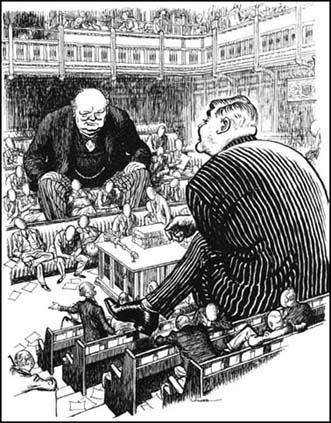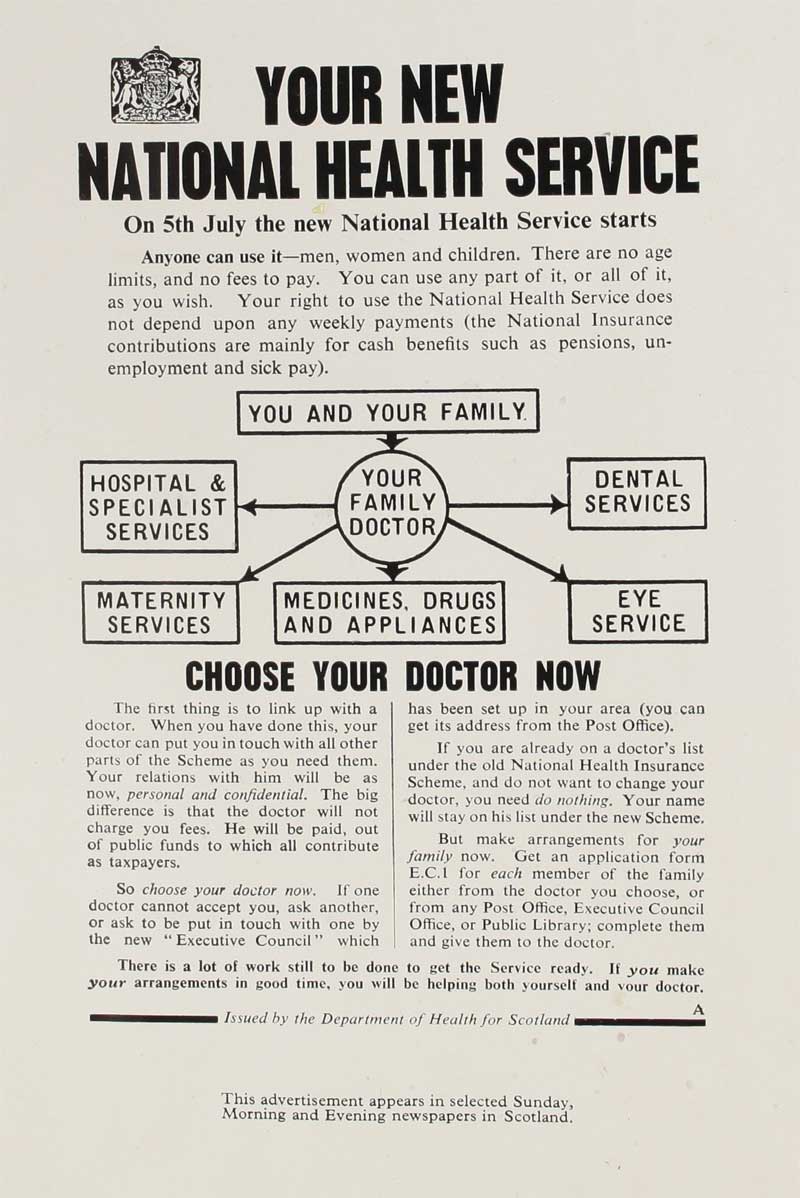History of NHS – 1948-1960
Mid and later 1940s – NHS launched 5th July 1948
1945 Harry S. Truman orders the atomic bombings of Hiroshima and Nagasaki (6 and 9 August)
Japan surrendered on 2 September, ending the war
1945 Labour Government (Clement Attlee MP)
1946 (July). Government. National Health Service Act 1946 published.
1947. Government. National Health Service (Scotland) Act 1947. Passed responsibility for the NHS in Scotland to the Secretary of State for Scotland.
1948 World Health Organisation
(WHO) founded
1948 (July). Creation of the NHS. Following WWII, Britain’s first majority Labour government, led by Clement Attlee, formulated plans for a comprehensive Welfare State. A free at point-of-delivery NHS was the cornerstone of these plans.
Famously the medical profession was largely unsupportive, with a BMA vote going against its creation.
In that BMA vote in 1948, only 4,734 doctors out of the 45,148 polled, were in favour of an NHS. Fortunately the government pressed on.
The chief architect of the NHS was Labour Minister of Health, Aneurin Bevan. On 5 July 1948, he launched the NHS at Park Hospital in Manchester (Trafford General Hospital).
When 13 year old Sylvia Diggory (nee Beckingham) was admitted to that hospital with a liver condition, she became the first patient to be treated by the NHS.

 Churchill and Bevan, two political heavyweights of the time
Churchill and Bevan, two political heavyweights of the time
“The time is now ripe for another great advance, and any one can see what large savings there will be in administration once the whole process of insurance becomes unified, compulsory and national. Here is a real opportunity for what I once called “bringing the magic of averages to the rescue”.
The NHS in Scotland and Northern Ireland were legally distinct from England from the beginning. Wales, however, was managed from England and treated much like an English region for the first 20 years.
This is what the ‘tripartite system’ of the new NHS looked like in 1948.
Hospitals
- State owned (nationalised) hospitals. 1.143 voluntary and 1,545 municipal hospitals became the responsibility of 14 Regional Hospital Boards in England and Wales.
- 36 ‘Teaching Hospitals’ – had different arrangements and were organised under Boards of Governors. Hospital consultants retained the right to conduct their private practice as well as gaining full-time salaried employment in the NHS. This is still the case.
- Managed by a medical superintendent, a matron and a lay administrator (called the ‘secretary’).
The national network of general practitioners extended (and replaced) the ‘panel system’ and included the entire population. GPs were responsible for primary healthcare and received fees which were set and paid nationally. They rejected the idea of having a salary, and so then (and now) are semi-independent of the NHS. This has pros and cons; mainly pros, as it enables them to stay nimble, and move with the times.
Each person would be registered to a specific GP. On 5 July 1948 (when the NHS officially ‘started’), 86% of all GPs joined it, and over the next six months the proportion rose to 96%.
Community and domiciliary health services
Maternity and child welfare clinics, health visitors, midwives, health education, ambulance services, public and environmental health and health promotion (including vaccination) continued to be run by City or County councils (Local Authorities), which were also responsible for housing, roads and education.
Management Structure
The NHS’s original management structures in 1948 consisted of:
- 14 Regional Health Boards (RHBs)
- 36 boards of governors for teaching hospitals (BGs)
- 388 hospital management committees (HMCs)
- 138 executive councils (ECs)
- 147 local health authorities (LHAs).

The strands of the tripartite system had, and still have, different funding streams and were managed separately. This was possibly the biggest mistake in the NHS – made at its creation.
Other Advisory Groups
The Central Health Services Council (CHSC) was created by the 1946 NHS Act and was the advisory mechanism for the Ministry of Health. It had substantial representation from the professions as well as members from local government and hospital management.
There were also Standing Advisory Committees: Standing Medical Advisory Committee (SMAC); Standing Nursing and Midwifery Advisory Committee (SNMAC), Standing Pharmaceutical services Advisory Committee (SPAC) and Standing Dentistry Advisory Committee (SDAC). Three of the Standing Committees were abolished in 2005, and one (dental) in 2010.
Even though we say the NHS ‘started’ in 1948, we hope you can see, it was really a development of previous organisations and Acts of Parliament. This gathered pace from the start of the Twentieth Century and the National Insurance Act 1911 was vital.
Impact
The NHS made an immediate impact on the health and imagination of the nation. In 1952, Aneurin Bevan said:
“The essence of a satisfactory health service is that the rich and the poor are treated alike,
that poverty is not a disability, and wealth is not advantaged.”

1948. Government. Health Services Act (Northern Ireland) 1948. Similar to the Scottish act of previous year; transferring responsibility for healthcare to the Northern Ireland parliament.
1949 Arab-Israeli War and Berlin Blockade begin
1949 NATO forms and Soviet Union tests the atomic bomb
1949 George Orwell publishes Nineteen Eighty-Four
Thus the NHS was born into an unstable and vulnerable world.
1949. Education. Nurses Act 1949 – established a framework for the role of nursing within the NHS.
1949. Government. National Health Service (Amendment) Act 1949 – safeguarded the independence of GPs. It also proposed prescription charges of not more than one shilling per prescription. However, due to intense opposition, the charges were not implemented until 1952.
1949. Public Health. First tuberculosis vaccine routinely offered to nurses.
The 1950s. Mental Health Services – Mental Health Act 1959
1950-53 Korean War (surrogate for Cold War)
After initial success in the eyes of the public, NHS costs started to spiral. So various services were then taken out of the new NHS. Mass vaccination and intensive care started. First Clean Air and Mental Health Act. First kidney transplant.
1950. Education. Medical Act 1950 – GMC introduced disciplinary boards (with a right to appeal); and a compulsory year of training for doctors after their university qualification. This took the form of two 6 month ‘house officer’ posts (or ‘housejobs’).
1950. Research. First UK report linking smoking to lung cancer.
1950. Management. The Bradbeer Report on the administration of hospitals, published in 1954, described high degrees of variation in both size and scope of different hospital types; and differences in culture between hospitals that had been previously owned by local authorities, versus the voluntary hospitals.
1951 Conservative Government (Winston Churchill MP/Sir Anthony Eden MP)
1952. Charges for prescriptions, dental care charges (mainly dentures) and glasses introduced. Originally ‘free’, charges for these items were now introduced – a shilling (5 pence) for a prescription. As of 2022 prescription charges remain in England, but were abolished in Wales, Northern Ireland and Scotland in 2007, 2010 and 2011.
1952. Education. Royal College of General Practice established.
1952. Clinical. Birth of Intensive Care Concept.
1953 Monarch. Queen Elizabeth II (1952 – 2022)
1953 First ascent of Mount Everest by Tenzing Norgay and Edmund Hillary
1953. Research. Structure of Deoxyribonucleic Acid (DNA) discovered.
 Francis Crick and James Watson
Francis Crick and James Watson
 Rosalind Franklin. ‘Photo 51’
Rosalind Franklin. ‘Photo 51’
This was taken by Rosalind Franklin and Ray Gosling in 1952, is one of the most important photographs in the long history of the human race. It demonstrated the helical structure of DNA; and thus a deep understanding of the mechanism of evolution by natural selection. Their discovery, including this photo, rank with Darwin’s ‘On the Origin of Species’.
1954. Management. The Bradbeer Report on internal administration of hospitals. The Bradbeer Committee published a report highlighting variation in methods of administration in different hospitals and recommending changes to their administration.
1954. Mental Health. The Royal Commission on the Law Relating to Mental Illness and Mental Deficiency (Percy Commission, which reported in 1957) – recommended, where possible, people with ‘mental disorders’ should be treated in the community, and not in large psychiatric institutions.
1955 Conservative Government (Sir Anthony Eden MP/Harold Macmillan MP)
1955. Clinical. UK’s First Kidney Transplant.
1956 Hungarian Uprising crushed by Soviet Union
1956. Public Health. Clean Air Act 1956 – was a response to worsening air pollution in urban areas of the UK. The Great Smog in London in 1952 killed an estimated 12,000 people.
1956. Management. NHS Graduate Management Training Scheme. In the context of a growing focus on the administrative structure of the NHS, the first national administrative training scheme started (a 2-year intensive training programme). The scheme would produce many of the NHS’s senior leaders over the next few decades, including Sir David Nicholson and Simon Stevens.
1956. Government. Guillebaud Report into the cost of the NHS – found, in relative terms, NHS spending had fallen between 1948 and 1954, from 3.75 per cent to 3.25 per cent of Gross National Product (now 9-10%); and that additional costs implied by an ageing population could be financed easily by economic growth.
1957 British Prime Minister, Harold Macmillan, has made an optimistic speech saying
“most of our people have never had it so good”
1957. Clinical. First prescription of the combined oral contraceptive pill.
1958. Public Health. First Mass Vaccination Programme – polio and diphtheria jabs were offered to under fifteens.
1959 Conservative Government (Harold Macmillan MP/Sir Alec Douglas-Home MP)
1959 World population reaches three billion (now almost 8 billion)
1959 First documented AIDS cases
1959. Clinical. First General ICUs in UK.
1959. Mental Health. Mental Health Act 1959 – recommended, where possible, treatment in the community; with mental and physical health having equal status.
1960 First Summer Paralympic Games hosted in Rome
1960 The Beatles form in Liverpool
By the start of the 1960s, there was hope for a calmer, more peaceful and prosperous world. The human race was starting to recover from the mass slaughter (and genocide) of two world wars.
Other resources
CKDEx has other related articles.
https://ckdexplained.co.uk/the-history-of-the-nhs-in-one-sentence/
https://ckdexplained.co.uk/early-history-of-nhs-1900-1948/
https://ckdexplained.co.uk/history-of-nhs-1960-1980/
https://ckdexplained.co.uk/history-of-nhs-1980-2000/
https://ckdexplained.co.uk/history-of-nhs-2000-present-day/
https://ckdexplained.co.uk/history-of-the-nhs-a-summary/
https://ckdexplained.co.uk/an-extremely-short-history-of-the-nhs/
https://ckdexplained.co.uk/history-of-nhs-timeline/
https://ckdexplained.co.uk/origins-and-prehistory-of-the-nhs/
The Health Foundation have an extremely good timeline here.
The Nuffield Trust has a detailed history of the NHS here and timeline here.
The BBC has historical charts here.
This is a short UK video on the early history of the NHS.
Last Reviewed on 25 June 2024
